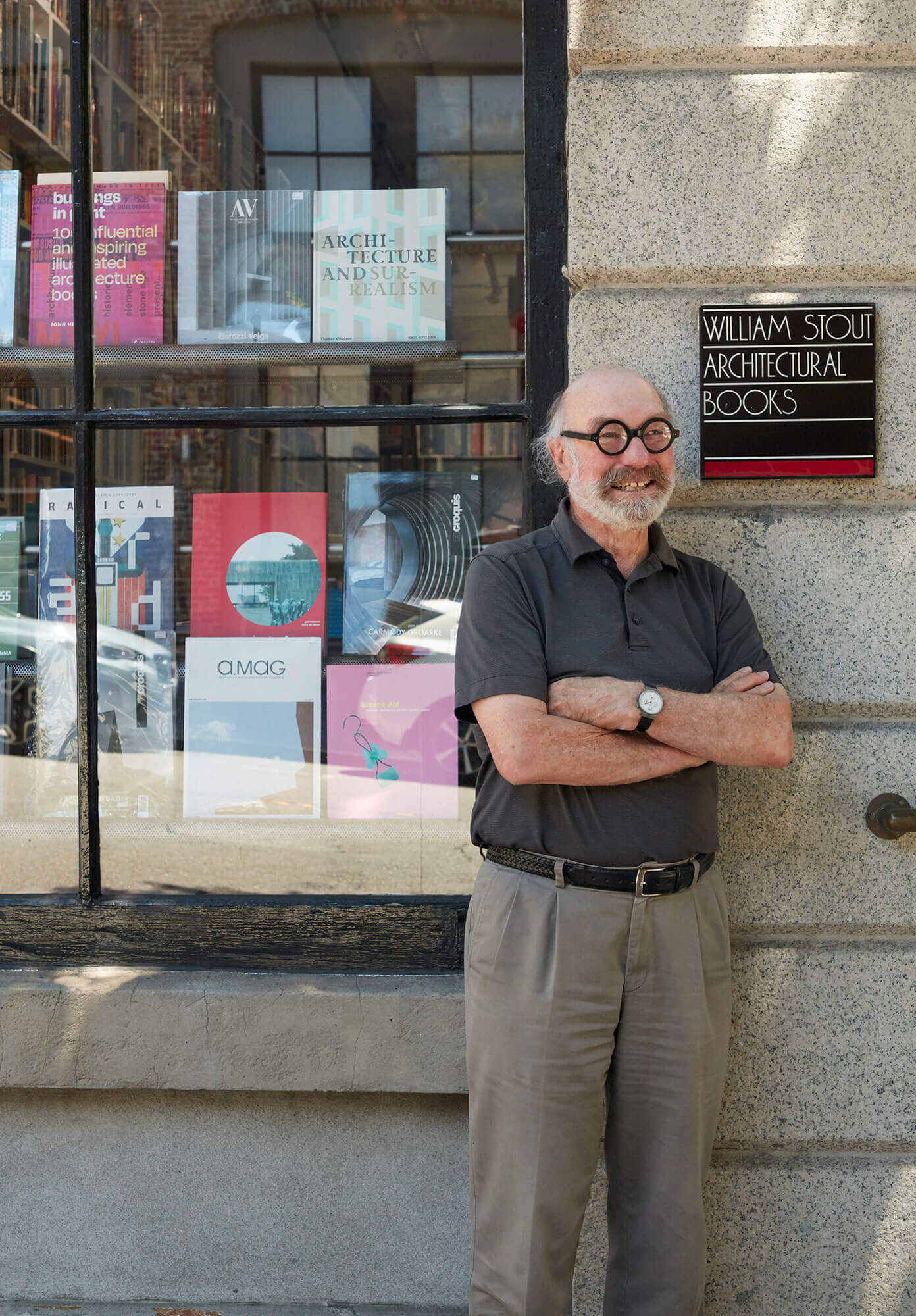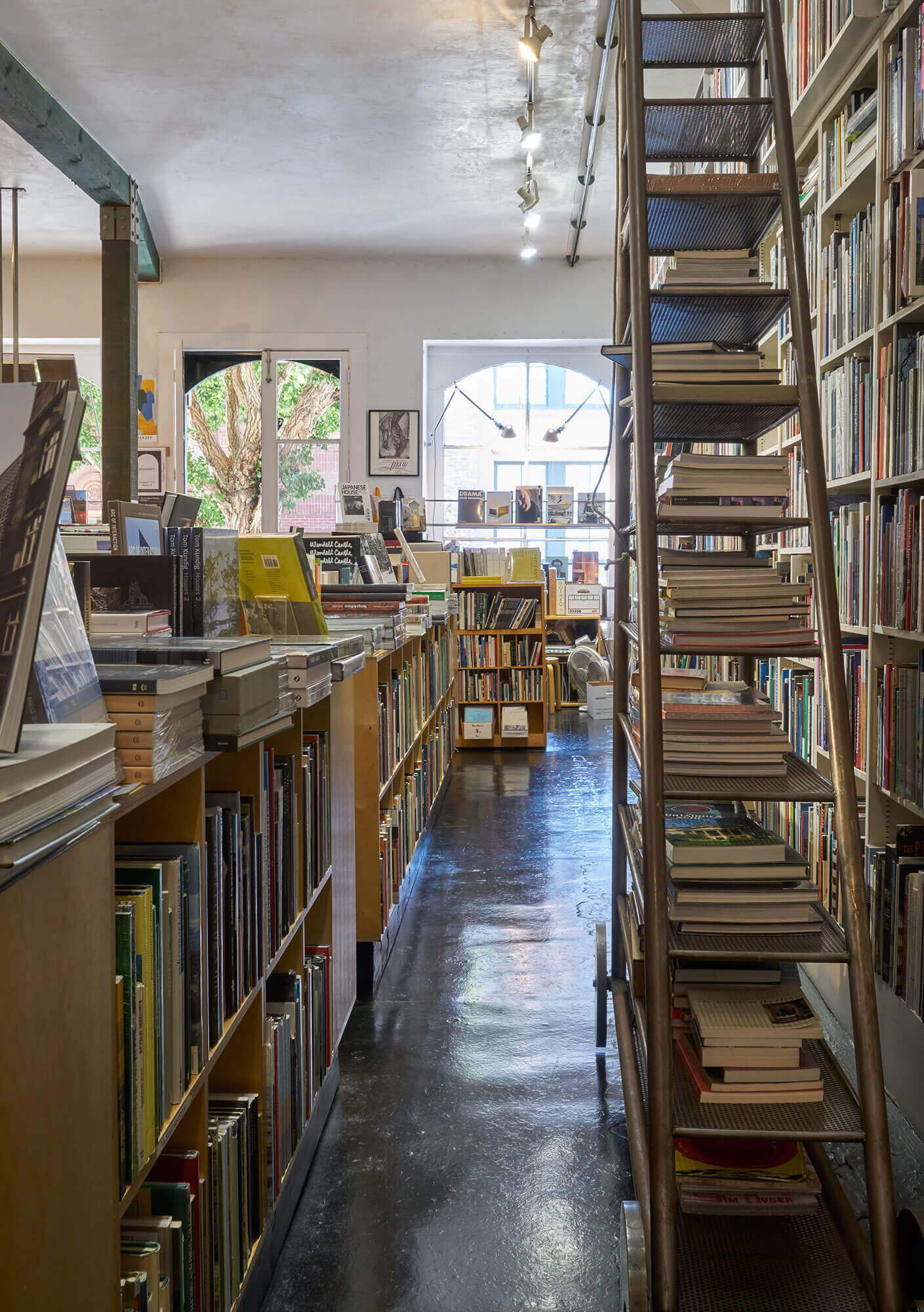At the corner of Montgomery and Washington streets, the shadowy wind tunnel of San Francisco’s financial district suddenly opens and the historic neighborhood around Jackson Square begins. The buildings drop down to two, three, and four stories, and an earlier architectural pattern of brick, stone, and wood-framed windows replaces concrete and steel. Two quiet blocks up, 840 Montgomery has been home to William Stout Architectural Books since 1984. On the December day I met Bill Stout and Erik Heywood there, jazz played amid the floor-to-ceiling stacks and tables spread with books. Stout and Heywood were behind the counter, looking at blueprints of Le Corbusier’s Villa Roche that the latter had brought from the former’s warehouse. The long-running store is going strong, but it now operates as part of the Eames Institute of Infinite Curiosity.
In October 2022, the organization acquired Stout Books, an act that followed its purchase of his personal collection of over 4,000 architectural monographs, books on history and theory, and graphics. The institute, led and curated by the Eameses’ granddaughter Lisa Demetrios, exists to preserve the Eames Ranch in Petaluma and its collection. “The reason for the acquisition is preservation. Stout Books is spiritually attached to our mission for how it contributes to the world of architecture and design,” Heywood told AN. As the institute’s retail director, he’s helming the bookstore, drawing on his experience as the founder of the Oakland-based Book/Shop.

Going through the Eameses’ materials at the ranch, Heywood realized that their design process began with models and mock-ups. They made things first, and the drawings came later. “We love the idea that as a designer and an architect, you still have permission to roll up your sleeves, get out some colored paper and a pair of scissors, and go to town,” he said. An enormous amount of care and creativity wove through everything the Eameses did: When they wrote a letter, it was handwritten, collaged, with drawings. “Going there you see a soulful, heartfelt imagination that’s often missing now in design practice. Bill’s bookstore is very much in that spirit.”
How Stout Books began
Bill Stout began collecting architecture books in the 1970s to build his own library, assuming other architects would want the same. Over the past 48 years, across multiple Bay Area locations and branches of work, he has curated a vast collection of books related to architecture, all facets of design, and planning with an architect’s sensibility.
Stout first began selling out of an apartment he shared with friend (and now renowned architect) Steven Holl at 1218 Montgomery; they were open at midday so architects could come by at lunch. It was just new books at the time, sourced from Europe and the first publisher he carried, Futagawa, from Japan. Chuck Bassett in SOM’s San Francisco office soon became Bill’s biggest patron. He was building a library at work and didn’t want his library committee spending too much time at Off Center—as Stout and Holl called the bookstore then—so he asked Stout to bring down a box of books every two months for them to consider and selectively purchase.
Returning from one such delivery, Stout spotted what would become his first real shop on Osgood Street. There was a beautiful garden in the back and an apartment above that he lived in—like Off Center and the Jackson Square basement where we spoke. He began adding out-of-print books and buying libraries, beginning with an incredible collection of Frank Lloyd Wright from a German professor then teaching at the University of Washington. At that time, he remembered that “there might have been 50 to 80 architectural offices—and probably ten or so just in the area. There was a lot of traffic.” He was at the epicenter of paper architecture—a movement of architectural writing and thinking that was at its height. Susie Coliver from ARCH Art & Drafting Supply moved in next door; Dan Friedlander opened Limn nearby; and Andrew Batey, Mark Mack, and others started Archetype magazine. He helped Peter Eisenman of the Institute for Architecture and Urban Studies in New York when IAUS put the Bay Area on its lecture circuit and sold its journal Oppositions and its books.
By the time he moved to the current location, the neighborhood had changed—lawyers replaced the architects—and his own collection and activities were expanding. From early on, Stout sent out extensive catalogs in the mode of Wittenborn to clients worldwide and the 200 libraries he stocked. Stout also wrote essays to preface the catalogs he did over the decades. Those essays are among the things that the Eames Institute hopes to resurface from all the work Stout has done over the years. “There is so much there,” Heywood said.

Stout Books turns to publishing
Starting in the early 1990s, Stout published books and research materials under his eponymous imprint, focusing on local architects and regional architecture, “things that might not get covered by the New York press.” He worked with Marc Treib on a series of titles drawing on the archives of UC Berkeley’s College of Environmental Design on architects like Bernard Maybeck, Joseph Esherick, and Garrett Eckbo. Among the last books he did was a monograph on Donald Olsen by Pierluigi Serraino and another by Dung Ngo, William Turnbull Jr.: Buildings in the Landscape. Jill Stoner’s Poems for Architects, based on the author’s use of poems as proj- ect prompts for her architecture students, is another one Stout likes to cite.
“We were rolling right along,” Stout recalled, “and then Amazon blew us out of the water.” Still, he held on, maintaining his price structure and approach, even as the coterie of independent bookstores in the Bay Area and around the country dwindled.
“There aren’t a lot of places where you can really dig into and explore design any- more,” Heywood said. When Stout’s library and his bookstore were in danger of disappearing, the Eames Institute entered the picture in the role of a preservationist seeking to keep the bookstore and library intact for researchers and people interested in architecture and design. “Having the Eames Institute involved is more of a hands-on process—experiences that can seep into people’s design thinking and practice—rather than a school where you are learning things in a very rational way that never works,” Stout explained.
For him, the acquisition is a perfect fit. “The institute now has a place in the city where they can have lectures and exhibitions. My libraries reinforce their attitude toward an institution that can research not only industrial design and design thinking but also architecture. And that is a pretty exciting idea, especially here in Northern California, because there isn’t anything like that.”
“Optimism is at the heart of the Eames Institute,” Heywood noted. “In the world right now, design needs optimism, interaction, and happiness to breathe new life into it. Our hope with what we are doing at the institute and this bookstore is that there is a flame that we keep going.”
Elizabeth Snowden is a writer, creative director, and editor based in Berkeley, California.











